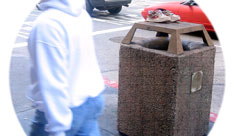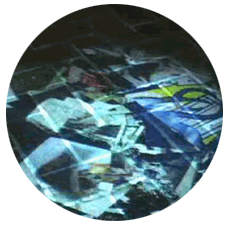|
|
|
|
|
|
|
|
|
|
|
|
||||||||
 |
|
|
||||||
|
|
||||||||
|
|
|
|
||||||
|
|
||||||||
|
|
||||||||
 |
|
|
||||||
|
|
|
|
||||||
|
|
||||||||

|

|
||||||||||||||||||||||||||||||||||||||||||||||||||||||||||
|
|
||||||||||||||
|
|
|
|
|
|
|
|
|
|
|
|
|
|
|
|
|
|
|
|
|
|
|
|
||||||||
|
ARTIFACT |
|
ARTIFACT PRODUCTION: AUGMENTED TRASHCAN |
|
|
|
We employ the results from the prior steps of the Urban
Probes methodology to directly influence the design of a functional urban
artifact. Our Trashcan Stalkings (Observation) revealed that a seemingly
banal part of the urban infrastructure is actually a focus of rich human
activity, a microcosm of social ecology. The urban computing question is:
The Lost Postcard Technique (Intervention) exposed an active curiosity towards discarded and/or lost objects and the people that once owned them. The question is:
Finally, our interviews revealed that most people not only create vivid stories about trash and lost objects left throughout a city but also manifest a voyeuristic curiosity about the people that discarded such objects. The question: How can technology embedded within the city’s
infrastructure facilitate and provoke story telling? |
|
SYSTEM ARCHITECTURE |
|
| Inspired by the preceding results and questions, we constructed a fully functional augmented trashcan. The augmented can exposes city dwellers to the pattern of trash interactions as told from the point of view of a single city trashcan. Two event types can be sensed: interaction events and trash in/out events (including the type of trash involved). We used a simple IR photoelectrical switch to detect a basic interaction with the trashcan such as searching. A sensitive electronic scale determines the current weight of trash entering or leaving the bin. Mounted within the trashcan, an overhead camera records the top layer of trash in the bin. A laptop computer connects the devices and projects an appropriate visualization from the trashcan’s opening onto the city street. | |
|
EXPERIENCE |
|
|
There are several methods of interaction with the
augmented trashcan: active, passive, and mobile. Tossing trash into or removing trash from the augmented trashcan is an active interaction. For example, after finishing her lunch while sitting on a nearby bench, Jill tosses her bag of trash away. The augmented trashcan detects the event as the item enters the bin. Using the camera and digital scale, information about the new trash is logged. Its weight is measured and a rough image of the trash is extracted by subtracting out the previous image of the top of the trash from the current. The isolated image of the trash, its time, and weight are all logged. After a short time, an image of the individual item is introduced into the animated, projected visualization. Any individual passing near the augmented trashcan interacts passively with it by observing its shifting visualization. Mounted inside the trashcan, a projector renders a view of the recent activity of the trashcan over time. Recall that an image of each piece of trash is captured by an overhead internal camera. This image is incorporated into a continuously projected visualization on the ground in front of the trashcan. Recent items appear closer to the base of the trashcan and slowly “orbit” outward over time. Each trash image also rotates on its axis based on its weight with heavy items spinning slowly and light items more quickly. When the system fails to isolate an item in trashcan image after an event, either because the image difference is too large (i.e. the trash fell over) or too small, an iconic representation of these events is substituted into the visualization. As time elapses, the orbiting “trash images” slowly progress outward, away from the trashcan eventually disappearing completely. The resulting visualization depicts a layering of trashcan activities and patterns, not unlike the archeological layers typically found during years of drought or catastrophic change. Will the lunch trash layer reveal itself? People passing nearby will be able to glance at the augmented trashcan’s visualization, noticing a familiar or unusual ebb and flow of trash within a local area of the city. The completed and fully functional augmented trashcan in action can be seen in in the following video:
|
|
|
Urban Atmospheres at Intel Research |